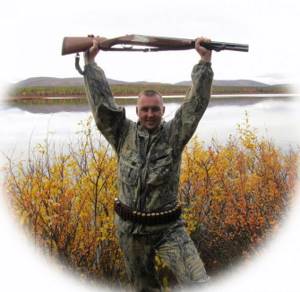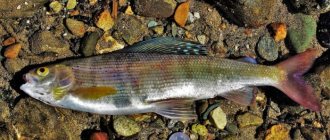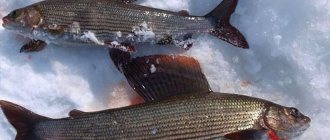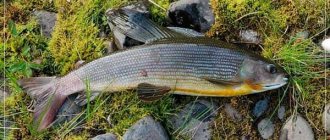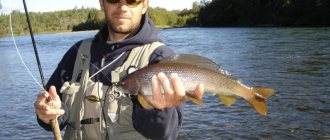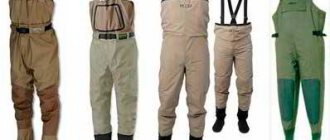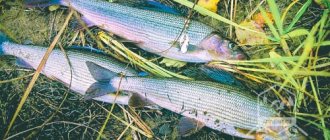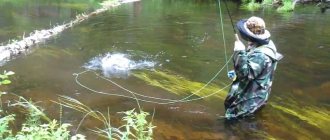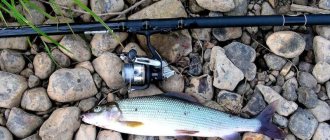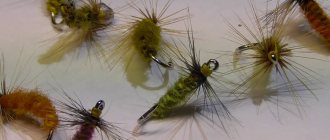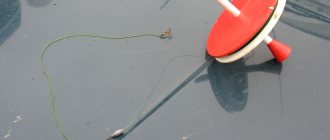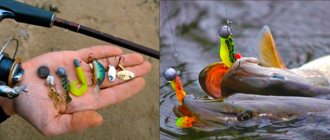Grayling - habitat and features of fishing for grayling
Grayling (lat. Thymallus) is a genus of fish of the grayling subfamily, salmon family, order Salmonidae. A characteristic feature is the large dorsal fin, the rear part of which in mature males, when folded, reaches the adipose fin, and sometimes even the base of the caudal fin.
Grayling of the Wild North in the Northern Urals, grayling in the Subpolar Urals, grayling in the Polar Urals, helicopter transfer for the purpose of grayling fishing.
There is only one genus in the grayling family - Grayling (Thymallus). All graylings are freshwater fish that live in small fast rivers and cold lakes in Europe, Asia and North America.
Given the wide habitat of graylings, they can be divided into several main subspecies.
Common or European grayling (Th. thymallus). It differs from other species of the genus by its small mouth (the upper jaw does not extend beyond the front edge of the eye). The teeth on its jaws are very weak, almost invisible, there are 20-29 gill rakers. Its color is very bright: there are small round black spots on the back and upper part of the sides, and brownish longitudinal stripes on the sides. Paired fins are yellow or red, unpaired fins are purple, and on the dorsal fin there are bright quadrangular spots arranged in rows. The mating plumage is expressed in increased brightness of color. In males, in addition, the height of the posterior part of the dorsal fin increases. The size of grayling does not exceed 50 cm, weight is usually 0.5-1 kg, but there was a case of catching a specimen in 4675. European grayling is quite widespread. Its range covers almost all of Europe - from France, England, Germany, Denmark, Scandinavia and Finland to the Ural Mountains. In the south it goes to Switzerland, the Danube and Dniester basins, and in the upper reaches of the Volga and the Urals. Grayling is absent only in the basins of the Dnieper, Don, Kuban, Crimea and the Caucasus. Wherever there are common grayling, it prefers fast rivers with clean water, where holes (barrels) alternate with riffles. In a number of places it also enters lakes - Ladoga, Onega, Imandra, from where it goes into rivers to spawn. The grayling of our North often reaches the estuarine areas of rivers (Kara Bay) and in some places is found in quantities sufficient for commercial fishing. In the East, the distribution limit of European grayling is the Ural Range
Another species common in Siberia is the Siberian grayling (Th. arcticus) , which differs from the European grayling in its large mouth size (the upper jaw reaches approximately the middle of the eye). The teeth on the jaws are more visible. The color is the same as that of the European one, but varies greatly: in large rivers there are light-colored forms, in small taiga streams - dark ones. The typical Siberian grayling lives in the basins of the Kara (where it lives together with the European), Ob and Yenisei rivers. To the south it goes to the Altai mountain reservoirs and the river. Kobdo in Northwestern Mongolia. Further east, the typical form is replaced by subspecies. We invite you to an exciting fishing trip for grayling in the Polar Urals and the West Siberian Lowland. On a helicopter tour to the north to fish for Siberian grayling.
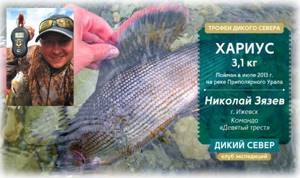
The photo shows a trophy grayling from the Subpolar Urals. It was caught by Nikolai Zyazev (a team from Izhevsk of the Wild North Expedition Club) in 2013 on one of the distant rivers of the Subpolar Urals, which can only be reached by helicopter. We offer you to take advantage of organizing grayling fishing in the North of Russia.
The graylings that inhabit Lake Baikal are very impressively colored. There are two forms here. Black Baikal grayling , reaching 53 cm in length and 1.2 kg in weight, lives in rivers flowing into Baikal and in the Lower Angara. Its body is dark olive, in places with a bluish tint and large copper-red spots. The pectoral fins are olive-yellow, the pelvic fins are yellow, with longitudinal copper-red stripes along the rays, the anal fin is red-purple, with blue wavy stripes, the caudal and adipose fins are crimson. The dorsal fin is especially bright - from the base to the top, along a dark olive background turning into green, there are longitudinal rows of brick-red, green, dark red and purple spots, ending at the top of the fin with a dark red border. Black grayling feeds mainly on the larvae of caddisflies, stoneflies and amphipods and, on occasion, diversifies its menu with flying insects that have fallen into the water and the eggs of sculpin gobies. Spawning in all tributaries of Lake Baikal occurs in early May, but in the Lower Angara, which flows from Lake Baikal and has a lower water temperature, from early June to mid-August.

East Siberian grayling (Th. arcticus pallasi) , which differs from the typical form in that its dorsal fin is shifted to the anterior end and the body is covered with smaller scales, reaches 44 cm in length. It inhabits the eastern part of Siberia, found in the rivers Pyasina, Taimyr, Khatanga, Lena, Yana, Indigirka, Alazeya, Kolyma and rivers of the Chukotka Peninsula. There is every reason to believe that the American grayling (Thymallus signifer), inhabiting the river. The Yukon (Alaska) and the Canadian rivers are very close, if not identical, to this form. The color of East Siberian grayling varies greatly. In Kolyma, for example, you come across dark, almost black specimens.
In the Amur basin, from the upper reaches to the estuary, in the rivers of the Sea of Okhotsk north to Gizhiga and the Ussuri region to the river. Suzukha is home to another subspecies - Amur grayling (Th. arcticus grubei) . In the r. The Yalu, which flows into the Yellow Sea, is apparently inhabited by a very similar form. It differs from the East Siberian in larger scales, and from the typical shape in the length of the dorsal fin. The back of the Amur grayling is lilac-gray, the sides are lighter, with small dark spots. There is a dark red spot above the ventral fins and an orange spot under the pectoral fins. Dorsal fin with rows of spots and a crimson border. Length up to 30 cm. Amur grayling avoids lakes and stays in mountain tributaries down to the smallest rivers, which in summer break up into a chain of deep barrels with almost dry connections. The graylings kept in these barrels are, as a rule, hungry and attack all living things that fall into the water, so catching them is very rewarding. Spawning at the end of May - June. The Amur grayling feeds mainly on aquatic insects and insects that have fallen into the water, but during the spawning of Far Eastern salmon it eats large quantities of their eggs washed from the nests. The Amur grayling fishery is exclusively local.

Lake Kosogol (Khuvsgol), located on the territory of the Mongolia, is home to the unique Kosogol grayling (Thymallus nigrescens) . It has more gill rakers than other graylings (29-33), the color is dark, uniform, without streaks, almost black during spawning, with a blue tint. Kosogol grayling matures at a length of 17–20 cm and reaches no more than 30 cm.
the Mongolian grayling (Thymallus brevirostris), also lives in the inland waters of Northwestern Mongolia .
It is very unique, and it has preserved primitive characteristics that clearly indicate the origin of grayling from ancestors close to salmonids. In particular, the mouth of the Mongolian grayling is very large (the end of the lower jaw extends beyond the posterior edge of the eye) and the teeth are well developed, which are reduced in other graylings. Perhaps the presence of this primitive species in the central parts of Asia indicates that it was here that the first representatives of the grayling family were formed, which then spread widely to the north, east and west.

Grayling fishing in the Polar Urals, helicopter tours with grayling fishing, helicopter transfer to the Yamal-Nenets Autonomous Okrug, Ural grayling, grayling in the Subpolar Urals.
According to many of its characteristics, grayling forms a kind of intermediate link between salmon and whitefish. It approaches the former by the formation of its mouth, lined with larger teeth than those of whitefish, also by its wide tongue, its way of life and location, the latter by its small mouth, body shape, rather large scales and smaller changes in age and sex, which are so significant in fish of the salmon genus.
Grayling is very easy to distinguish from all other fish by its huge dorsal fin, which sometimes, being folded, almost reaches (in males) the tongue-shaped adipose fin that characterizes the entire salmon family. Its body is less slabby and more compressed than that of salmon, trout and taimen, and is covered with rather large, dense and tightly held scales; only on the chest and belly up to the pelvic fins are there extremely small scales, and at the base of the pectorals are more or less developed bare areas visible
In terms of color, grayling is one of our most colorful and beautiful fish. Its back is usually gray-green, dotted with more or less numerous and clear black spots, the sides of its body are light gray with longitudinal, but sometimes, however, inconspicuous brownish stripes; the belly is silvery-white. Paired fins are usually dirty orange, and unpaired fins are purple with dark stripes or spots. Young graylings are always less brightly colored and usually have dark transverse stripes. The color of grayling, however, is subject to great changes: in fast waters it is much lighter; grayling living in pools are more steely in color. It is not easy to spot grayling in the water, as it is difficult to distinguish it from the ground and stones. Grayling of the rivers of the Northern Urals, Subpolar Urals, Polar Urals - Northern Ural grayling, somewhat different from the ordinary one; It is he who never has a large number of streaks and the longitudinal stripes on him are very inexpressive.
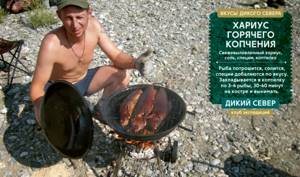
Grayling, according to some reviews, in wild, hard-to-reach and little-visited rivers grows up to 3 kg, but usually fishermen catch fish weighing from 200 to 700 grams. Grayling weighing more than 1 kilogram is already considered an enviable trophy. It has been noticed that in fast-flowing rivers, grayling are always larger than in calmer bodies of water.
Grayling mainly lives in mountainous areas, cold and fast-flowing rivers of north-eastern Russia and throughout Siberia, where it is also found in lakes.
Grayling is generally distinguished by great agility and liveliness and in this respect is in no way inferior to trout, since it disappears instantly, like a shadow. On a sunny day, it very often jumps out of the water, brightly shining with the iridescent colors of its wide fin, and grabs fallen insects. His jumps are sometimes amazing; but, nevertheless, he, apparently, soon gets tired, which is also noticed when catching him with a fishing rod. Grayling leads an almost diurnal lifestyle and feeds exclusively during the day; Its main food consists of insects falling into the water from the branches of trees hanging over the river, which is why it likes to stay in such places, also midges and mayflies, larvae of water insects and water snails, for which it often pokes its head into stones, which is why it is called in some areas a blacksmith. In addition, it destroys the eggs of other fish, which may very well be the reason that in those rivers where grayling is numerous, all carp fish, despite the huge amount of their eggs and with a sufficient number of quiet bays and old or side channels, are very common rarely. Occasionally, he also eats young fish, mostly in the fall, when there is a lack of his main food—insects.
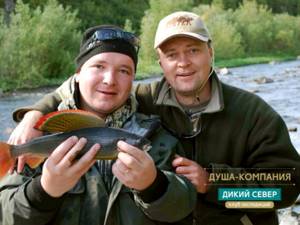
In the photo are members of the expedition club “Wild North”: Razumkov Valery and Skvortsov Dmitry Grayling in the Subpolar Urals, fishing for grayling in the north of Russia, fishing for Siberian grayling, helicopter tours for grayling
For most of the year, graylings live in small schools, which become smaller the older they reach. There is some reason to assume that until they reach maturity, a flock of young graylings constitutes, so to speak, like one family; but at certain times, adult individuals also form small flocks, also mostly of the same age. Young graylings usually live in shallower places and on rifts, while large ones already prefer more or less deep holes, where, after all, they no longer face any danger from the predatory taimen.
Grayling's favorite habitats are above and below rapids and rifts; they often come out to fatten on the latter. From mid-September, grayling no longer stays in the rapids and goes into holes and creeks for the winter. According to fishermen, in warm times grayling goes to faster and shallower places, and in cold times it looks for sandy and deeper places. In some places in the fall it gathers in numerous flocks and sometimes descends from the upper reaches of rivers into large rivers and lakes, where it is not found at all in spring and summer. In general, this is one of the most sedentary fish. It has even been noticed that throughout the summer, graylings constantly stand in the same places during the day, leaving them only in the evening, when they go out to the riffles or rapids, where the water still flows in an even stream, so that it is convenient for the fish to look out for falling insects on it. During the day, grayling usually stay in deeper places, in the grass and behind rocks, approaching the shallow shore to feed, where the current is stronger and there is no grass. Here the grayling stands in one place, constantly jumping to the surface for insects swimming past. Sometimes up to a dozen of them gather on a rocky shallow, but not side by side, but apart, and each takes a special position, from which it moves away only at the sight of a swimming insect; the grayling swims out to meet him, rushes at him, or, seeing him from afar, catches up with him, grabs him and then immediately returns to his place. Its movement, caused by the current, is limited to a circle no more than a meter in diameter. That each grayling really sticks to a certain point is proven by the fact that the largest or smallest is always seen in the same place, and also by the fact that the place occupied by the fished grayling remains vacant for several days; then it deals, in all likelihood, with the new newcomer.
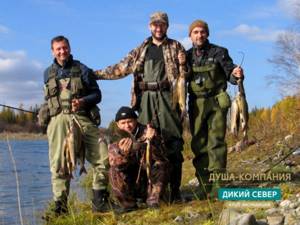
Very large graylings emerge from the holes onto the rapids only at night, rarely during the day. They prefer to stand in corridors formed by grass, or under steep banks, where it is easier for them to hide. Here they also always stay in one place and alone.
In early spring, sometimes even before the rivers open, grayling leave the places where they spent the winter and rise upward from the lower reaches of the rivers. At this time, they are found alone and are brighter in color, especially the males, of which there are apparently more than females. Sometimes, however, there are also sterile ones - barren individuals, distinguished by shorter fins and less bright coloring, but very fatty.
The spawning itself takes place at shallow depths and even rifts and in general terms (except for time) is very similar to the spawning of other salmonids. It usually begins in May, even at the beginning of June. Spawning sometimes lasts a very long time - almost a whole month. Graylings, like other closely related fish, release their eggs in several stages, but this may also depend on the fact that the largest graylings play first. Usually all this time they are found in pairs - a female with one male, rarely with two or three. Then they can often be seen rubbing their bellies against stones, causing almost the entire belly to be exposed to scales and turn red. To house their not particularly large testicles, females are said to dig small holes with their caudal fin and, after fertilization, cover the eggs with small pebbles.
The eggs develop quite quickly; young fish have a small yolk sac and rise to the surface of the water shortly after hatching; grow very quickly. Under favorable conditions, grayling reaches a weight of about 500 grams within 2 years. and even more, and generally reaches sexual maturity already in the third year.
After spawning, graylings again gather in small schools and very soon eat off.
Grayling - bait, fishing methods.
Spinning fishing.
Grayling is the most capricious fish when fishing - today it is caught perfectly, tomorrow, under the same conditions, it does not take at all, although it catches falling flies.
To catch grayling weighing no more than 1 kg, use a light class rod up to 2.1 m long; When fishing in lakes, preference should be given to a longer (2.5 m) spinning rod. Since grayling have a smaller mouth than most salmon fish, the most catchy ones are spoons 2-5 cm long and weighing 1-6 g. The most popular are spinners of the “rotating petal” type, however, when catching larger fish, small oscillating spoons are also quite suitable . With small spoons and light rods for catching grayling, only spinning reels, and primarily open ones, can be recommended. The fishing line should have a diameter of 0.2-0.25 mm, and only when catching large fish weighing over 1.5 kg, as well as in difficult conditions, should you use a fishing line with a diameter of 0.3 mm. A characteristic feature of fishing for grayling with a spinning rod is to move the spoon as slowly as possible. This gives a much greater effect than when catching other fish, and the winner will always be the angler who selects a lure that can be cast as slowly as possible in a given current. Grayling rarely actively pursues prey: its hunt is of a wait-and-see nature, and it most often rushes to the lure that is held in the immediate vicinity of its stopping place. Equally important is identifying the potential location where the fish should be holding. Grayling does not really like strong currents and, as a rule, stays in calmer water. It almost always stands at the bottom and only in the calmest parts of reservoirs sometimes slowly swims in search of food, and in streams it hunts within the entire width of the riverbed. This must be taken into account when baiting. When the grayling sees something edible at the surface of the reservoir, it begins to rise and grabs the prey (sometimes they say “sucks up” it) at some distance below its position. If the examined object turns out to be inedible, the grayling turns over and goes back, often even with a small splash, which makes it possible to judge where it is staying.
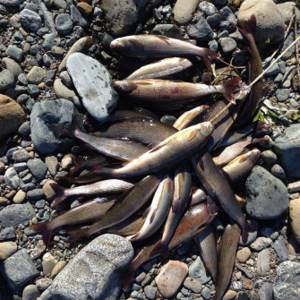
According to the observations of fishermen, grayling is less likely to rise for prey swimming away from its resting place, so many believe that the bait should be fed directly to the grayling, and deviations to the side by more than 20-30 cm negatively affect its grip. The fisherman and spinning player must take this into account and try to cast with utmost precision. The casting distance is almost irrelevant. In lakes, grayling should be looked for most often in rocky areas in the coastal zone on the leeward side. In places where the depth increases quite steeply, grayling can be caught at a distance of 3-5 m from the shore.
If splashes of fattening fish on the surface of the reservoir are not visible, it means that it is either standing in cover or hunting in the bottom layers, and the lure should be cast deep. When grayling picks up food from the surface, you should slowly move the spoon at a very shallow depth. Sometimes this technique helps to seduce grayling, which behaves passively.
Fly fishing.
In fly fishing, two methods are most widespread - fishing with a “dry” fly and fishing with a “wet” fly, which also includes nymph fishing. The gear used, tactics and fishing techniques in both cases do not differ so significantly, however, special attention should be paid to certain nuances.
The rod and reel used when fly fishing with a “dry” or “wet” fly are usually the same. The rod chosen is of a light class with a length of 2.2-2.7 m. A short rod is convenient in small rivers and streams, long rods are useful in cases where it is necessary to cast over long distances. When fishing for grayling with a “dry” fly, only floating lines of the 5-7th weight class are used, when fishing with a “wet” fly, floating lines with a sinking end are used, and in shallow reservoirs with a slow current, floating lines can also be used. Lines that sink along their entire length for catching grayling are rarely used and only in certain conditions. Which line - conical or parallel - does not matter much, since a smooth and imperceptible transition to the fly is ensured by the undergrowth. The positive properties of cheap cylindrical cords should not be neglected. For example, casting with such a line over a short distance is easier to do than with a conical line, because the conical part is lighter. Recently, in the practice of fly fishing, a cylindrical or conical fly fishing line up to 10 m long (the so-called “torpedo”), which is used to cast the fly to the desired place, is increasingly being used. Its advantages are especially obvious when fishing in deep places, as well as in cases where a “wet” fly needs to be cast at a distance of 20 m or more.
There are several considerations when choosing a leash. Typically, a fishing line with a diameter of 0.15-0.2 mm is used. But if you need to use flies with a hook number 2.5 or smaller, then it is more advisable to use a leader with a diameter of 0.12 mm. In most cases, this is only possible in fairly clean, unclogged reservoirs. Leashes made of fishing line with a diameter of 0.2-0.25 mm are used in cases where it is expected to catch fish weighing 1 kg or more and if the conditions for fishing are clearly poor. The undergrowth is made using the same principle. In low and clear water, in clear and calm weather, a longer leader is used to ensure a smooth lowering of the fly. When it is windy, use a short undergrowth, otherwise the accuracy of casting is significantly reduced.
Artificial flies used for catching grayling are, in most cases, somewhat smaller than trout flies. “Dry” flies differ from “wet” ones in two main ways. For tying “dry” flies, raw materials with a low specific weight are used - synthetic threads and ribbons, as well as thin and light hooks. In addition, using various methods of winding various bristles and feathers, “dry” flies are made more fluffy and difficult to get wet, as a result of which they can float on the surface of a reservoir. “Wet” flies, on the contrary, are distinguished by sparse plumage, are tied on thicker and, accordingly, heavier hooks, and wires and metal ribbons are used to additionally weight them when tying. These flies “work” in the water column, right down to the lower layers of the reservoir. As a “wet” fly, you can use a simply wet or clipped “dry” fly.

A few more words about the behavior of grayling. There is an opinion that grayling is a cautious fish. Maybe this is true if you compare it, for example, with a gudgeon or a ruff. It is possible that there are conditions when grayling behaves very carefully, but it would be more accurate to consider it a capricious fish or picky with regard to bait and its behavior in the water.
Since grayling spawns in the spring, its fishing season begins (depending on the end of the freeze-up) at the end of May or June, i.e. 1-2 weeks after the end of spawning. In northern reservoirs, grayling spawning is sometimes observed even in early July. Fishing usually begins after the rivers return to their channel and the water begins to lighten. At this time, it is quite often possible to catch the largest fish for a given reservoir, which immediately after spawning are actively feeding and have not yet had time to choose suitable summer shelters. They fish with a spinning rod equipped with a small spinner and fly fishing, using medium-sized “wet” flies that look like drowned mayflies, stoneflies or larvae, as well as small flies 2-3 cm long that imitate fish. In spring, large grayling stays near the bottom, so it is advisable to lead the fly deep, examining places with various eddies, especially those areas where the current is moderate and there are a lot of large stones at the bottom. Places with washed out banks near areas with a rocky or pebble bottom are also potentially catchy. When fishing with a “wet” fly, two methods of leading the bait are most often used - floating it freely with the flow and forced slow pulling against or across the current. If in the first case the fly imitates some kind of food carried away by the current, then in the second case the fly resembles a small fry.
Similar manipulations are also possible with a “dry” front sight. For example, if an imitation of stoneflies is used while they are flying over a reservoir, the active movement of the fly along the surface of the water is sometimes very effective on grayling. When fishing with a “wet” fly, a “dry” fly—a “jumper”—is often tied to the undergrowth. The main purpose of the “jumper” is to help monitor the bite. Bites, especially when the fly is floating freely, are usually very difficult to catch. They manifest themselves as a twitch, a sudden shine near the fly, a pause in the passage of the line, or simply in the form of some subtle oddity in the passage of the line or leash. This serves as a signal for hooking. It is especially difficult to catch the moment of a bite when fishing in the deep layers of a reservoir. Here the fisherman needs to develop a special instinct. To make it easier to notice a bite, you can use auxiliary means: for example, make a winding of light thread at the end of the cord or put a bright plastic tube on it.
In the summer, along with the already mentioned insects, whose life is connected with the reservoir - stonefly, caddisfly, mayfly, insects that accidentally fall into the water - grasshoppers, gadflies, mosquitoes, flies, beetles and ants - begin to play a significant role. Imitations of these insects are most successfully used during the daytime. They are also effective in rivers with a poorly developed food supply. However, with the onset of dusk, grayling can also be caught well with flies imitating mayflies or stoneflies. In this case, preference should be given to those samples that are more visible in poor visibility conditions.
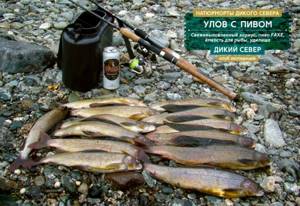
Grayling fishing with a spinning rod, grayling fly fishing, grayling fishing tour, grayling spawning rivers of the Khanty-Mansiysk and Yamalo-Nenets Autonomous Okrug
Grayling fishing reaches its climax in autumn. It is in the fall that all the delights of fly fishing are fully revealed. With the first frost, when the trees begin to turn bright colors, it is time for grayling to become more active. It is successfully caught both with a worm and with an artificial fly, which, if conditions permit, should be preferred. The results of fishing with a spinning rod are usually worse. This can be partly explained by the fact that in the fall grayling feed on smaller insects. There are cases when grayling regularly picks up such miniature flies from the surface of the water that it is even difficult to reproduce them in the form of imitation. At this time, small specimens of artificial mayflies, mosquitoes, ants or small fancy flies are catchable.
Briefly about biting and fishing. When fly fishing on riffles and in most cases when fishing with a spinning rod, grayling takes the bait sharply, hooks itself and does not need to be hooked. But when fishing on a flat current, the fly fisherman should not yawn. As already mentioned, a sign of a grip can be, for example, only the appearance of a fish near the fly. The hooking should not be very sharp, otherwise with a thin leash it threatens to lose the fly. But you can’t be late either. If the angler waits for the moment when he feels the grip of the rod, as a rule, it is already too late to hook.
The mouth cavity and lips of grayling are soft, and if a hook, even a small one, gets stuck into them, the fish very rarely manages to get rid of it. Immediately after hooking, the grayling behaves in a peculiar way - it begins to shake its head, trying to free itself from the hook, or stubbornly adheres to the direction opposite to the one in which the angler is leading it. However, grayling gives up pretty quickly. When fishing, grayling does not try to go into snags, stones or grass, but stays in open water. Therefore, fishing should not be forced, especially when fishing with thin tackle. The grayling should not be lifted to the surface of the water immediately after hooking, which will only lead to desperate jerks; it is better to calmly lead it to the intended place at depth. The pulled fish is taken by hand or with a landing net, preferably in the form of a tennis racket.
Unfortunately, theory cannot provide ready-made recipes for all situations in life. It can only become a means to facilitate the search for the most suitable solution in each case, which the fisherman, I repeat again and again, must find himself, based on the specific situation. Almost every angler goes through several stages on the path of improvement - from a beginner, eager to catch at least some fish in any way, to the level when he can be considered an experienced angler. In the latter case, paradoxically, the fisherman is less interested in the quantitative side of the catch. He is quite satisfied with the fact that he had the opportunity to visit a beautiful river, watch the sunrise or spend the sunset and during this time feel, feel the bite. Only in the latter case can we say that maturity has come to the fisherman, experience has come.
We invite you to take a fascinating helicopter trip (helicopter tour) to the Northern Urals, Subpolar Urals, Polar Urals, as well as to any region of Western Siberia for the purpose of fishing for grayling.
Helicopter expeditions of the Wild North club. Routes with helicopter transfer from the Wild North club. Helicopter excursions of the Wild North club.
WE INVITE YOU TO SIGN UP FOR SUMMER HELICOPTER EXPEDITIONS
Authors of the article:
|
Svitov Evgeniy Vyacheslavovich (Expedition Club “Wild North”) Tel.7 |
Timing of the spawning ban on fishing in the Sverdlovsk region in 2020
Prohibited periods (periods) for the extraction (catch) of aquatic biological resources:
It is prohibited to harvest (catch):
a) all types of aquatic biological resources:
from April 25 to June 15 - in the reservoirs Chernoistochinsky, Verkhne-Makarovsky, Nizhne-Tagilsky, Lenevsky, Nevyansk, Verkhne-Vyysky, Nizhne-Vyysky, Verkhne-Saldinsky, Isinsky, Nizhne-Saldinsky, Petrokamensky, Beloyarsky, Volchikhinsky, Novo-Mariinsky , Ayatsky and Isetsky; lakes Melkoe, Tavatuy, Baltym; the Iset River from the source to the backwater of the Verkh-Isetsky reservoir and the Reshetka River; (Paragraph as amended, put into effect on April 1, 2021 by order of the Ministry of Agriculture of Russia dated February 18, 2021 N 62.) from May 15 to June 15 - in the Artinsky, Nizhne-Serginsky, Verkh-Neivinsky, Pogorelsky, Staroutkinsky, Afanasyevsky reservoirs, Artinsky, Nizhne-Turinsky, Verkhne-Turinsky, Rezhevsky, Revdinsky, Mikhailovsky, Bilimbaevsky, Kushvinsky, Polevsky and Atigsky, as well as in lakes Shitovskoye, Shartash, Chusovskoye and Dikoe; (Paragraph as amended, put into effect on April 1, 2021 by order of the Ministry of Agriculture of Russia dated February 18, 2021 N 62.) from May 1 to May 30 - in other water bodies of fishery importance in the region; from May 1 to June 15 - in the Lozva River from the source to the mouth of the Bolshaya Umpia River;
b) whitefish: from September 20 to November 20 – in Lake Tavatuy; c) from October 20 to November 15 – Siberian grayling everywhere.
Species of aquatic biological resources prohibited for production (catch): Siberian sturgeon, nelma, taimen, common sculpin.

